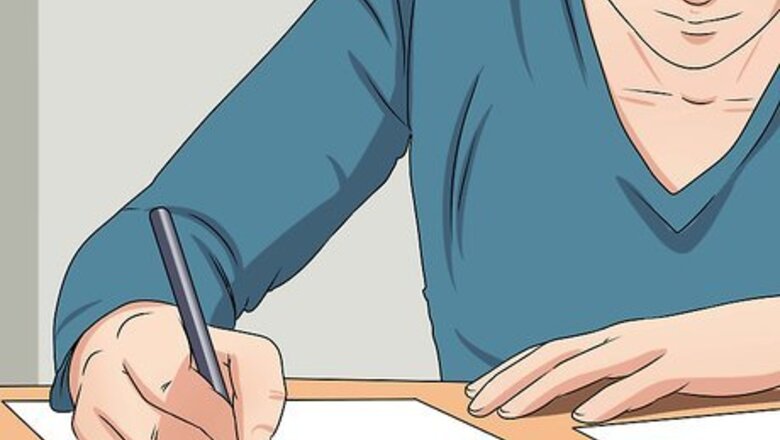
views
Emailing Your Child’s Teacher
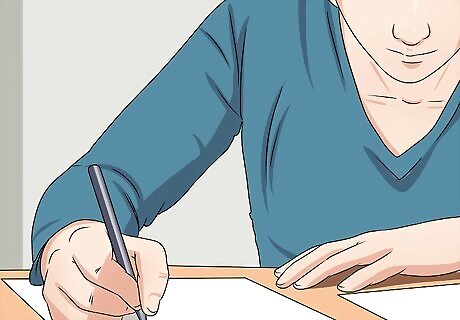
Recognize when to write. There are many different reasons you may want to contact your child’s teacher. They can be as simple as an introduction to addressing more serious concerns. The following are some time you may want to write the teacher: Introduce yourself after you’ve moved or your child is starting in a new school Discuss a problem Ask questions about assignments or your child’s performance Request a meeting Inform the teacher about special circumstances such as disabilities or family issues Excuse your child because of illness or an appointment.

Collect necessary information. Gather any information you need to compose a thorough and professional email to write to the teacher. Having all of the necessary information can prevent extensive correspondence and also shows that you respect the teacher and take the issue seriously. Ask your child what she calls her teacher or search the school’s website for her name. Have copies of any supplemental documents ready. For example, if your child has a disability, you may want to include a copy of the doctor’s diagnosis and any educational placements documents.

Compose a first draft. Use the information you collected to write a draft email to your child’s teacher. This gives you time to completely state your concerns, consider what you’ve written and make changes. Avoid writing the email address in the “to” field so that you don’t accidentally send the first draft. Keep the draft as concise and brief as possible. Keep the tone of the email personal, polite, and professional. Include a brief introduction with your and your child’s names and why you’re writing. For example, write “Dear Mrs. Maier, My name is Teresa Lutz and I am Sophia Lutz’s mother. I am writing because she is having difficulty in math class.” Aim to keep the body of the email between 1-3 paragraphs. Address any issues or concerns you like. You may also want to consider asking the teacher how you can help support her and your child in a constructive manner. Close the email by thanking the teacher for her consideration and offering your contact information for further consultation. For example, “Thank you for your consideration about Sophia’s difficulties. Feel free to contact me any time by email or phone at (555) 555-5555. I look forward to working with you to find a solution to Sophia’s problem.”
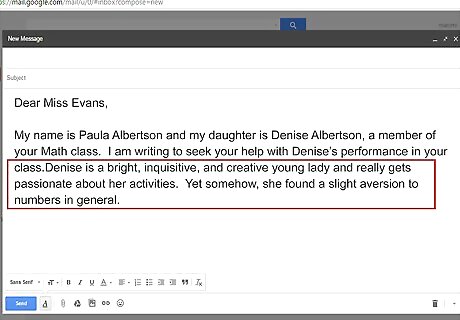
Keep the tone positive. When you’re composing your draft, aim to keep the language as positive as possible. It’s easy to get upset about something when it’s about your child. Keeping the tone of your email positive and proactive can set up an open and productive dialogue with your child’s teacher. Avoid using any accusatory language with the teacher. Use verbs such as understand, collaborate, and talk. Use adjectives such as positive and proactive. Combine words in phrases like “I understand from Sophia she’s having a difficult time with math. She and I would like to make a proactive change to this and we are wondering how we can work with you to improve her performance.”
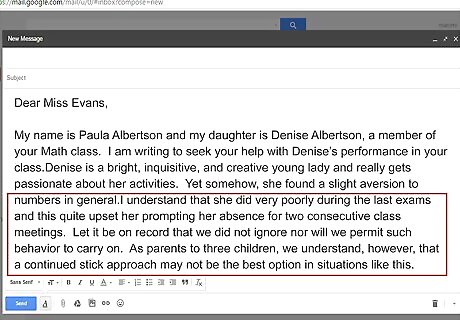
Be honest. Kids are often brutally honest and lying in a letter may be exposed by a simple slip of your child’s tongue. Be as honest as possible in your letter while maintaining a professional tone. Be direct. For example, “I have a work trip to a museum and would like to take him with me for an extra-curricular learning experience. Could you please let him and me know what homework he will need to complete when he returns to class on Friday?”

Think over and edit your email. After you have a preliminary draft email, give yourself some time to think over the content and tone. After this, make any necessary edits. Not only does will give you a chance to add or remove text, but also can help you catch spelling, punctuation or grammatical errors. Check that the revised email has an introduction, body, and closing that are honest and as positive and proactive as possible. Read the letter out loud to yourself, which can help you notice possible mistakes or phrases that may say accusatory or negative. Consider asking a friend, your spouse, or other educational professional to read the letter. This person can make suggestions on the letter to make it stronger or more positive.
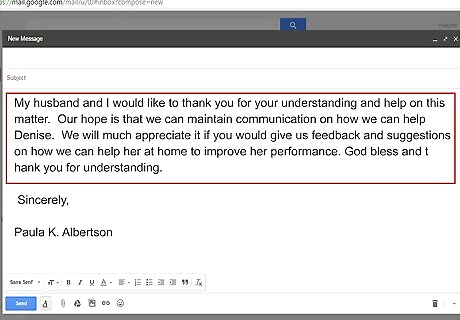
Put in a pleasant greeting and closing. After you’ve made changes to the draft, write in a pleasant and professional greeting and closing. This can help make the teacher more receptive to the letter and set the tone for a constructive response. Write the greeting how your child addresses her teacher. For example, “Dear Mrs. Maier” followed by a comma. If you are not sure if the teacher is married, use “Ms.” Instead of “Mrs.” Avoid using the teacher’s first name unless you’ve met her before and she’s extended the offer to call her by her first name. Close with “Sincerely” followed by a comma. Consider also writing “I look forward to hearing from you” followed by sincerely to prompt the teacher that you’d like a response. Include your name and how the teacher can contact you.
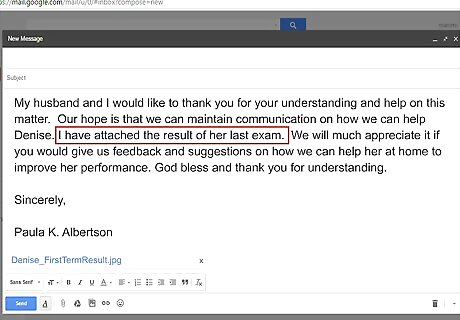
Attach relevant documentation. Depending on the nature of your email, include any documentation that clarifies your concerns. This can give the teacher reference to the case and understand the issue better. Make sure to the files are in an easily accessible format.
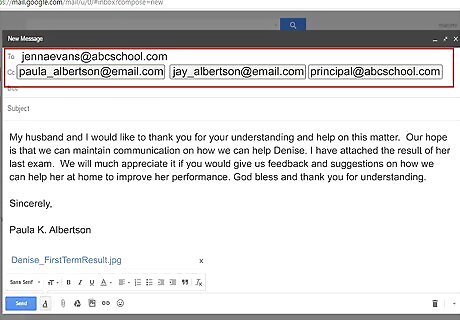
Address the email. You’ll need to put in the teacher’s email address before you can send it. Check on the school’s website to make sure that you have the correct spelling and format of her email. Copy any other necessary parties such as your spouse or another teacher involved in the matter. Consider blind copying yourself to have an extra copy of the email as well as make sure the email successfully sends.
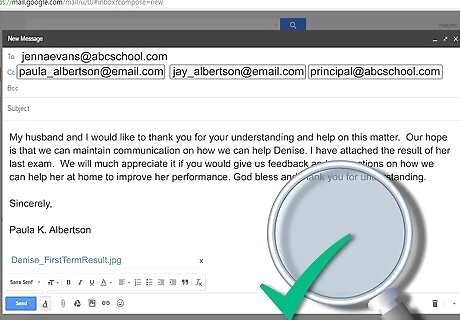
Proofread the final draft. Read over your email one final time before sending it. This can minimize the risk that you forgot to include something or made mistakes.
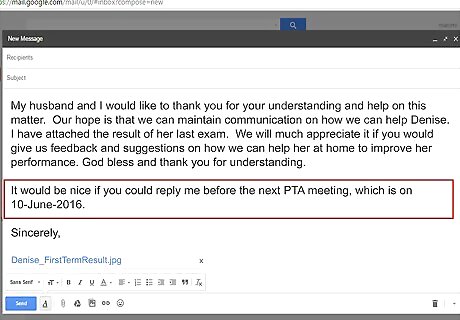
Give the teacher time to respond. Teachers are busy and often may not have time to respond right away or may want to consider your note. Allow your child’s teacher some time to respond before following up. Specify a date if you need a timely response. Follow up on your email or letter if you haven’t received a response within a week.
Sending a Handwritten Letter to the Teacher

Consider when to send a handwritten note. Handwritten notes are a more personal form of correspondence than email. There may be some situations when you may want to send the teacher a handwritten note. These include: A thank you note A brief introduction An excuse to leave class or for illness.

Write as neatly as possible. You want to make sure the teacher can easily read your note. Make sure your handwriting is heat while you are composing your note. Write slowly if you have bad handwriting. This may help you more clearly form your letters. Avoid using pencils or pens that smudge easily. A ballpoint pen is likely your best option. Consider writing a preliminary draft on your composing and transferring the text by hand for your note. This may help you think in more detail about what you’d like to write. Print out your note from the computer and sign it by hand if you prefer.
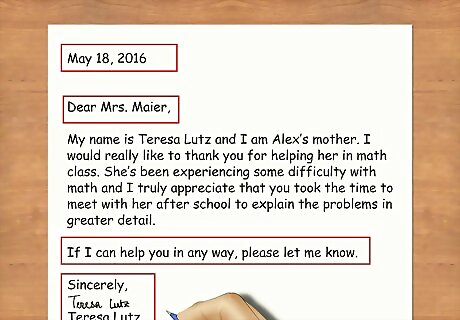
Write your note. If you prefer to write by hand to the teacher, you can follow the same process as for an email. However, if the situation is something less serious, such as a thank you note, you may not need to compose multiple drafts. Use personalized stationery if you have it. If not, use a clean and unwrinkled piece of plain paper. Write the date at the top of the paper. Put your greeting under the date. For example, “Dear Mrs. Maier” followed by a comma. Use the same elements as you did in the email. Remember to keep the note as brief and concise as possible. For example, “Dear Mrs. Maier, My name is Teresa Lutz and I am Sophia’s mother. I would really like to thank you for helping her in math class. She’s been experiencing some difficulty with math and I truly appreciate that you took the time to meet with her after school to explain the problems in greater detail. If I can help you in any way, please let me know. Sincerely, Teresa Lutz.” Sign the note with your signature and include a printed version of your name below it if need be.
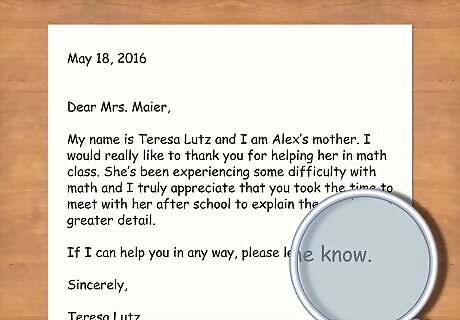
Check over the note. Before you send your note, proofread it. This can ensure there are no mistakes, that you haven’t forgotten anything, or that there aren’t smudges or illegible parts. Rewrite the letter if there are considerable mistakes.
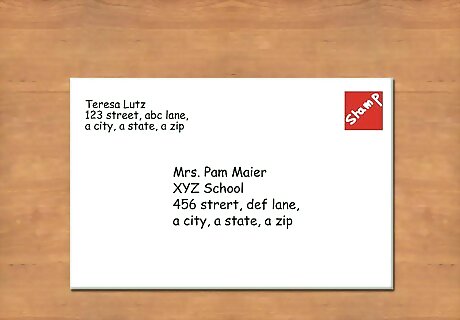
Deliver the note. There are many different ways you can deliver the handwritten note to your child’s teacher. Depending on the formality of the note or if you want to ensure it arrives by a certain date, you can deliver the note in the following ways: By mail. Make sure you address the letter to the teacher and then put the school’s information under it. By hand. Drop off the note in the office for the staff to deliver to the teacher. With your child. You can also send the note with your child. Just be aware that she may forget to deliver it. Consider pinning it to her coat where the teacher can see it if you want.




















Comments
0 comment